Effecting Durable Change: A Team Approach to Improve Environmental Behavior in the Household
Staats, H., Harland, P., & Wilke, H. (2004). Effecting Durable Change: A Team Approach to Improve Environmental Behavior in the Household. Environment and Behavior, 36(3), 341-367.
Dynamic norms promote sustainable behaviour, even if it is counternormative.
Sparkman, G., & Walton, G.M., (2017). Dynamic norms promote sustainable behaviour, even if it is counternormative. Psychological Science, 28(11), 1663-1674.
Testing the effects of social norms and behavioral privacy on hand washing: A field experiment.
Lapinski, M. K., Maloney, E. K., Braz, M., & Shulman, H. C. (2013). Testing the effects of social norms and behavioral privacy on hand washing: A field experiment. Human Communication Research, 39(1), 21-46.
Household Actions Can Provide a Behavioral Wedge to Rapidly Reduce US Carbon Emissions
Dietz, T., Gardner, G.T., Gilligan, J., Stern, P.C., Vandenbergh, M.P. (2009). Household actions can provide a behavioral wedge to rapidly reduce US carbon emissions. Proceedings of the National Academy of Sciences of the United States of America, 106(44), 18452-18456.
The effects of social norms on male hygiene.
Nalbone, D. P., Lee, K. P., Suroviak, A. R., & Lannon, J. M. (2005). The effects of social norms on male hygiene. Individual Differences Research, 3(3), 171-176.
Norms for Environmentally Responsible Behaviour: An Extended Taxonomy
Thogersen, J. (2006). Norms for environmentally responsible behaviour: An extended taxonomy. Journal of Environmental Psychology, 26(4), 247-261.
Planned Behavior and "Local" Norms: An Analysis of the Space-Based Aspects of Normative Ecological Behavior
Carrus, G., Bonnes, M., Fornara, F., Passafaro, P., & Tronu, G. (2009). Planned behavior and "local" norms: An analysis of the space-based aspects of normative ecological behavior. Cognitive Processing, 10(Suppl2), S198-S200. doi:10.1007/s10339-009-0292-9.
Emotions and Actions Associated with Norm-Breaking Events
Wilson, D., & O'Gorman, R. (2003). Emotions and actions associated with norm-breaking events. Human Nature, 14(3), 277-304. doi:10.1007/s12110-003-1007-z.
The Relative Influence of Attitudes and Subjective Norms from Childhood to Adolescence: Between-Participant and Within-Participant Analyses
Trafimow, D., Brown, J., Grace, K., Thompson, L., & Sheeran, P. (2002). The relative influence of attitudes and subjective norms from childhood to adolescence: Between-participant and within-participant analyses. The American Journal of Psychology, 115(3), 395-414.
Existential Threat and Compliance with Pro-Environmental Norms
Fritsche, I., Jonas, E., Kayser, D., & Koranyi, N. (2010). Existential threat and compliance with pro-environmental norms. Journal of Environmental Psychology, 30(1), 67-79. doi:10.1016/j.jenvp.2009.08.007.



